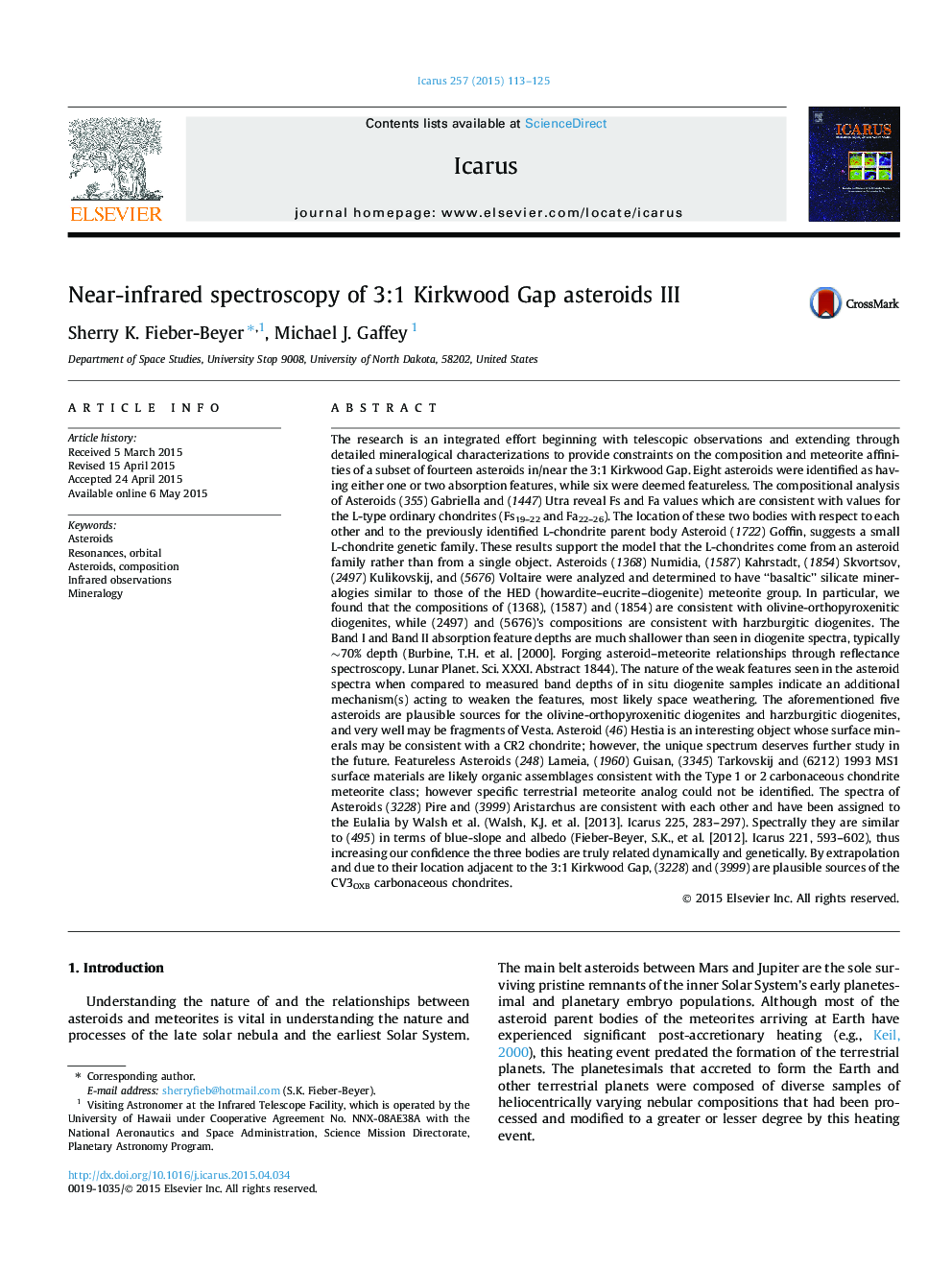| کد مقاله | کد نشریه | سال انتشار | مقاله انگلیسی | نسخه تمام متن |
|---|---|---|---|---|
| 8136101 | 1523533 | 2015 | 13 صفحه PDF | دانلود رایگان |
عنوان انگلیسی مقاله ISI
Near-infrared spectroscopy of 3:1 Kirkwood Gap asteroids III
دانلود مقاله + سفارش ترجمه
دانلود مقاله ISI انگلیسی
رایگان برای ایرانیان
کلمات کلیدی
موضوعات مرتبط
مهندسی و علوم پایه
علوم زمین و سیارات
علوم فضا و نجوم
پیش نمایش صفحه اول مقاله

چکیده انگلیسی
The research is an integrated effort beginning with telescopic observations and extending through detailed mineralogical characterizations to provide constraints on the composition and meteorite affinities of a subset of fourteen asteroids in/near the 3:1 Kirkwood Gap. Eight asteroids were identified as having either one or two absorption features, while six were deemed featureless. The compositional analysis of Asteroids (355) Gabriella and (1447) Utra reveal Fs and Fa values which are consistent with values for the L-type ordinary chondrites (Fs19-22 and Fa22-26). The location of these two bodies with respect to each other and to the previously identified L-chondrite parent body Asteroid (1722) Goffin, suggests a small L-chondrite genetic family. These results support the model that the L-chondrites come from an asteroid family rather than from a single object. Asteroids (1368) Numidia, (1587) Kahrstadt, (1854) Skvortsov, (2497) Kulikovskij, and (5676) Voltaire were analyzed and determined to have “basaltic” silicate mineralogies similar to those of the HED (howardite-eucrite-diogenite) meteorite group. In particular, we found that the compositions of (1368), (1587) and (1854) are consistent with olivine-orthopyroxenitic diogenites, while (2497) and (5676)'s compositions are consistent with harzburgitic diogenites. The Band I and Band II absorption feature depths are much shallower than seen in diogenite spectra, typically â¼70% depth (Burbine, T.H. et al. [2000]. Forging asteroid-meteorite relationships through reflectance spectroscopy. Lunar Planet. Sci. XXXI. 1844). The nature of the weak features seen in the asteroid spectra when compared to measured band depths of in situ diogenite samples indicate an additional mechanism(s) acting to weaken the features, most likely space weathering. The aforementioned five asteroids are plausible sources for the olivine-orthopyroxenitic diogenites and harzburgitic diogenites, and very well may be fragments of Vesta. Asteroid (46) Hestia is an interesting object whose surface minerals may be consistent with a CR2 chondrite; however, the unique spectrum deserves further study in the future. Featureless Asteroids (248) Lameia, (1960) Guisan, (3345) Tarkovskij and (6212) 1993 MS1 surface materials are likely organic assemblages consistent with the Type 1 or 2 carbonaceous chondrite meteorite class; however specific terrestrial meteorite analog could not be identified. The spectra of Asteroids (3228) Pire and (3999) Aristarchus are consistent with each other and have been assigned to the Eulalia by Walsh et al. (Walsh, K.J. et al. [2013]. Icarus 225, 283-297). Spectrally they are similar to (495) in terms of blue-slope and albedo (Fieber-Beyer, S.K., et al. [2012]. Icarus 221, 593-602), thus increasing our confidence the three bodies are truly related dynamically and genetically. By extrapolation and due to their location adjacent to the 3:1 Kirkwood Gap, (3228) and (3999) are plausible sources of the CV3OXB carbonaceous chondrites.
ناشر
Database: Elsevier - ScienceDirect (ساینس دایرکت)
Journal: Icarus - Volume 257, 1 September 2015, Pages 113-125
Journal: Icarus - Volume 257, 1 September 2015, Pages 113-125
نویسندگان
Sherry K. Fieber-Beyer, Michael J. Gaffey,